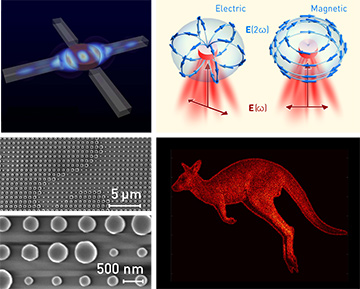 Top left: Anapole nanolaser exhibiting near-field lasing action. Top right: Electric vs. magnetic second-harmonic generation in nanoantennas, with distinct polarization patterns for the generated electric and magnetic multipoles. Bottom: SEM images of fabricated meta-optics holograms (left) and an encoded holographic image at 1600-nm wavelength (right).
Top left: Anapole nanolaser exhibiting near-field lasing action. Top right: Electric vs. magnetic second-harmonic generation in nanoantennas, with distinct polarization patterns for the generated electric and magnetic multipoles. Bottom: SEM images of fabricated meta-optics holograms (left) and an encoded holographic image at 1600-nm wavelength (right).
Nanophotonics aims at efficient nanoscale light manipulation, with many potential applications. Achieving the desired functionalities requires flexible control over the near- and far-field properties of nanostructures. Researchers now exploit both modal and multipolar control of the linear and nonlinear optical response of nanoscale elements to enhance near-field interaction and optimize radiation directionality.1 In particular, using the Kerker effect, strong directional scattering of light can be realized through the interference of magnetic and electric dipole resonances excited simultaneously with comparable strengths.2
While nanophotonics to this point has relied largely on plasmonic nanostructures, ohmic losses at optical frequencies substantially limit the achievable performance (and, thus, practical use) of these devices. An alternative platform, based on high-index dielectric nanoparticles, has recently emerged, opening the prospect of all-dielectric resonant nanophotonics and meta-optics.2 In this realm, high-permittivity nanoparticles exhibit strong interaction with light due to the excitation of electric and magnetic Mie-type resonances. The entire field of nano-optics in such subwavelength dielectric geometries thus rests on multipolar modes and their interference.
Our group recently suggested a nanoscale laser designed on these principles, based on a tightly confined anapole state, produced by interference of the dipole and toroidal modes.3 Designed as an optically pumped semiconductor nanodisk, it enables efficient coupling to waveguides and new mechanisms of mode-locking for ultrafast laser pulse generation, offering an attractive platform for advanced photonic circuitry.
Multipolar generation can completely reshape nonlinear effects at the nanoscale. Using Mie resonances in high-index dielectric nanoparticles could represent a promising strategy to gain high efficiencies of nonlinear processes at low modal volumes, and to create novel functionalities originating from an optically induced magnetic response.
These techniques have allowed us to discover novel regimes of nonlinear optical magnetism in nanoantennas, and to distinguish the nonlinear contributions of electric and magnetic responses experimentally by analyzing the structure of polarization states of vector beams in second-harmonic generation by continuously tuning polarization of the optical pump.4 Generated electric multipoles can be distinguished from magnetic multipoles in the far-field by their polarization.
Multipolar effects also allow broadband operation of meta-optics holograms.5 In particular, putting together concepts of complex wavefront engineering and multimodal resonant response, we designed highly transparent silicon holograms that allow high-resolution images to be encoded.
These developments in nanoscale optical control suggest significant opportunities for signal processing, optical computing, biosensing and super-imaging.
Researchers
Sergey Kruk, Daria Smirnova and Yuri Kivshar, Australian National University, Canberra, Australia
References
1. D. Smirnova and Y. Kivshar. Optica 3, 1241 (2016).
2. A. Kuznetsov et al. Science 354, aag2472 (2016).
3. J.T. Gongora et al. Nat. Commun. 8, 15535 (2017).
4. S. Kruk et al. Nano Lett. 17, 3914 (2017).
5. L. Wang et al. Optica 3, 1504 (2016).
